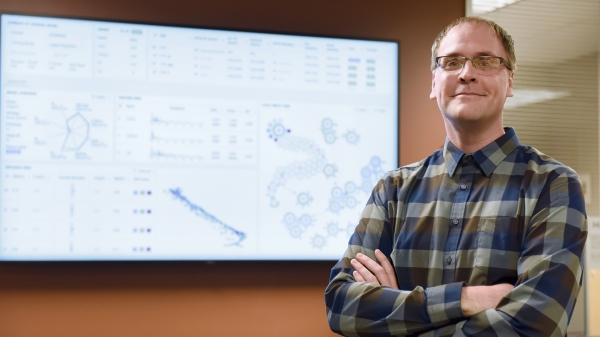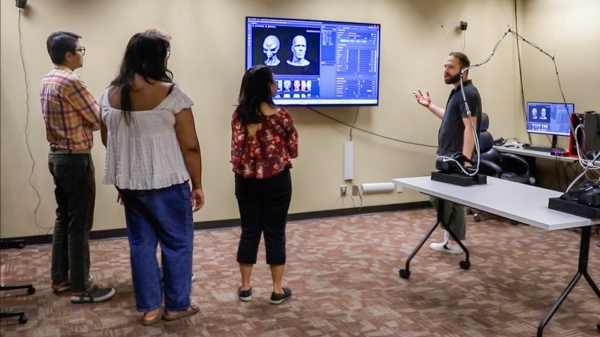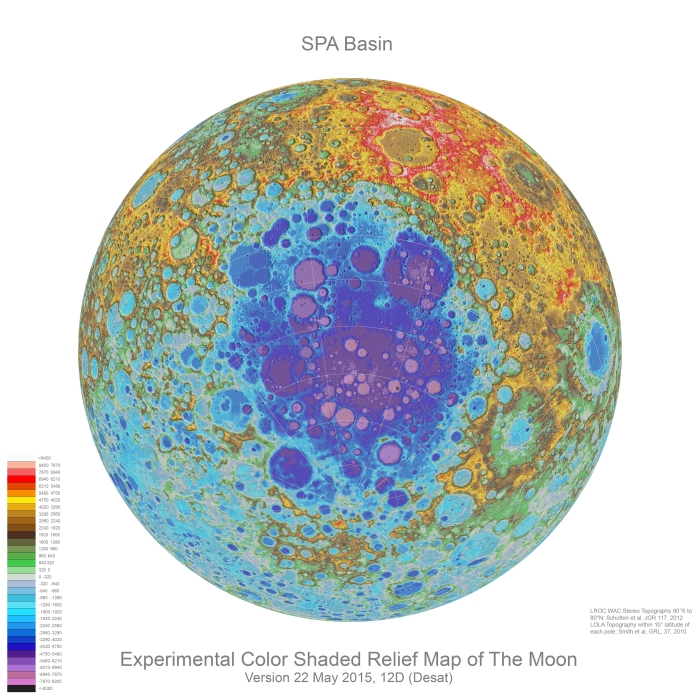Zircon crystals serve as time stamps for lunar impact events

A view of the moon's largest impact feature, the South Pole–Aitken basin, so named because it stretches between Aitken crater and the moon's south pole. The orthographic projection here centered on the basin (53 degrees south, 191 degrees east) highlights how much of the lunar farside was affected by this ancient impact event. Image courtesy NASA/GSFC/ASU
Defining our moon's origin and how it formed from a dramatic collision between Earth and another body the size of Mars several billions of years ago has been a topic of discussion by researchers for decades.
Analyzing data from lunar zircon crystals collected during the Apollo missions, a team of researchers led by Assistant Professor Melanie Barboni of Arizona State University's School of Earth and Space Exploration and Dawid Szymanowski of ETH Zurich unearthed a remarkable concentration of zircon ages, all tightly clustered around 4.338 billion years.
If the team is correct, the zircon age peak could mark the enormous impact that created the South Pole–Aitken basin on the far side of the moon — the largest known impact crater in the solar system spanning over 2,000 km wide (nearly the distance from Tempe, Arizona, to Mt. Hood, Oregon). This peak in the zircon age is significant as it provides a key reference point for early lunar chronology. The results of their study were recently published in Science Advances.
An impact of this magnitude would have excavated lunar mantle material from great depths. The recent study suggests the zircons Barboni and Szymanowski dated appear to have likely crystallized within the impact melt sheet as it cooled and differentiated. Subsequent impacts could have then distributed these zircons across the lunar surface.
If the dated zircons indeed correspond to the South Pole–Aitken impact, it will confirm this basin as one of the oldest on the moon, serving as a crucial reference point for early lunar chronology. An impact of such magnitude would have also played a significant role in shaping the development of the lunar crust and mantle.
Barboni and Szymanowski's analysis proposes some exciting implications for the state of the early solar system over 4.3 billion years ago. An impact of this size hints at a still-dynamic solar system, with large objects continuing to collide with planets and moons. If the moon experienced such dramatic events, the Earth likely did as well.
Recent research linking the cluster of 4.338-billion-year-old zircons to the South Pole–Aitken impact may provide the first accurate date for this significant event. The South Pole–Aitken basin is a crucial feature in the moon's history, believed to have been formed by a massive impact. This research sheds light on the tumultuous early history of the Earth-moon system and suggests a time when both the Earth and moon were still being regularly reshaped by large impacts.
“Getting the exact timing of such a large impact is of course critical for our understanding of the moon and the process that shaped it, but it is even more critical for our understanding the evolution of Earth. I am as much an Earth scientist as I am a planetary scientist, and I realize that my interest in the moon and other planets is always motivated by the same end goal — understanding my own world,” Barboni said.
Additional research and funding information
This research is supported by NASA's Emerging Worlds Program and the National Science Foundation. The study analyses were made in the Thermal Ionization Mass Spectrometry Lab at Princeton University and the Origins Lab at University of Chicago, with additional analyses conducted at UCLA's Ion Microprobe Laboratory, which received grant funding from the National Science Foundation's Chemistry Research Instrumentation and Facilities Program.
More Science and technology

ASU computing school director honored with prestigious award
Today, in an increasingly complex world, lawmakers and leaders must make big decisions, and they must often do so very quickly.Because of this, data visualization is an increasingly important…

Discovering new materials using AI and machine learning
The United States, in recent years, has been struggling with a supply shortage of critical materials needed for advanced materials discovery and manufacturing. Widespread delays have impacted sectors…

ASU researchers experiment with breakthrough tech exploring human communication, perception
Digital manipulation of video images, whether for blockbuster films or malicious intent, also known as deepfakes, has become commonplace. But the ability to create realistic-looking and -…
